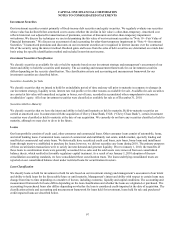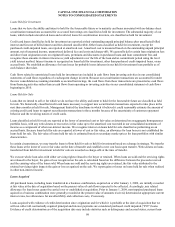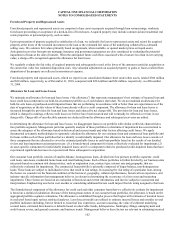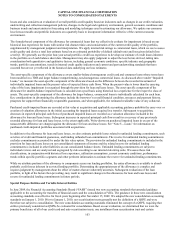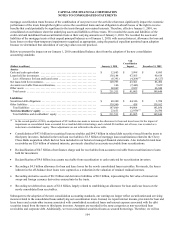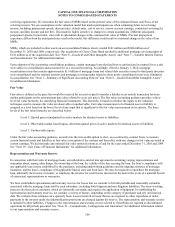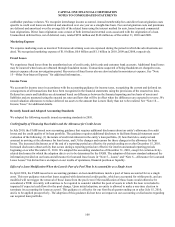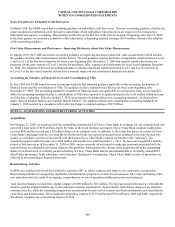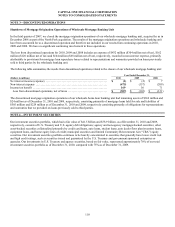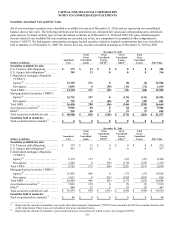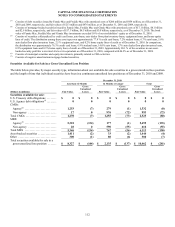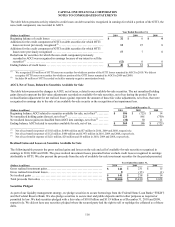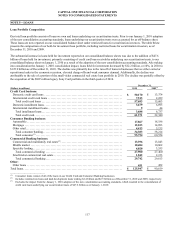Capital One 2010 Annual Report Download - page 127
Download and view the complete annual report
Please find page 127 of the 2010 Capital One annual report below. You can navigate through the pages in the report by either clicking on the pages listed below, or by using the keyword search tool below to find specific information within the annual report.CAPITAL ONE FINANCIAL CORPORATION
NOTES TO CONSOLIDATED STATEMENTS
107
Rewards Liability
We offer products, primarily credit cards, that provide reward program members with various rewards such as airline tickets, free or
deeply discounted products or cash rebates, based on account activity. We establish a rewards liability based upon points earned which
are ultimately expected to be redeemed and the average cost per point redemption. As points are redeemed, the rewards liability is
relieved. The estimated cost of reward programs is primarily reflected as a reduction to interchange income. The cost of reward
programs related to securitized loans is deducted from servicing and securitizations income. Rewards liability totaled $1.5 billion and
$1.3 billion as of December 31, 2010 and 2009, respectively.
Derivative Instruments and Hedging Activities
In accordance with applicable accounting standards, all derivative financial instruments, whether designated for hedge accounting or
not, are reported at their fair value on our consolidated balance sheets as either assets or liabilities. Derivatives in a net asset position
are included on in other assets, and derivatives in a net liability position are included in other liabilities. Our policy is not to offset fair
value amounts recognized for derivative instruments and fair value amounts recognized for the right to reclaim cash collateral or the
obligation to return cash collateral arising from derivative instruments recognized at fair value executed with the same counterparty
under master netting arrangements. As of December 31, 2010 and 2009, we had recorded $229 million and $254 million, respectively,
for the right to retain cash collateral and $668 million and $338 million, respectively, for the obligation to return cash collateral. The
accounting for changes in the fair value (i.e., gains and losses) of a derivative instrument differs based on whether the derivative has
been designated as a qualifying accounting hedge and the type of accounting hedge. For those derivative instruments that are
designated and qualify as hedging instruments we must designate the hedging instrument, based upon the exposure being hedged, as a
fair value hedge, a cash flow hedge or a hedge of a net investment in a foreign operation.
For derivative instruments that are designated and qualify as fair value hedges (i.e., hedging the exposure to changes in the fair value
of an asset or a liability or an identified portion thereof that is attributable to a particular risk), the gain or loss on the derivative
instrument as well as the offsetting loss or gain on the hedged item attributable to the hedged risk is recognized in current earnings
during the period of the change in fair values. For derivative instruments that are designated and qualify as cash flow hedges (i.e.,
hedging the exposure to variability in expected future cash flows that is attributable to a particular risk), the effective portion of the
gain or loss on the derivative instrument is reported as a component of other comprehensive income and reclassified into earnings in
the same period or periods during which the hedged transaction affects earnings. The remaining gain or loss on the derivative
instrument in excess of the cumulative change in the present value of future cash flows of the hedged item, if any, is recognized in
current earnings during the period of change. For derivative instruments that are designated and qualify as hedges of a net investment
in a foreign operation, the gain or loss is reported in other comprehensive income as part of the cumulative translation adjustment to
the extent it is effective. For derivative instruments not designated as hedging instruments, the gain or loss is recognized in current
earnings during the period of change in the fair value.
We also enter into derivative agreements with our customers to transfer, modify or reduce their interest rate or foreign exchange risks.
As part of this process, we consider the customers’ suitability for the risk involved, and the business purpose for the transaction. These
derivatives do not qualify for hedge accounting and are considered trading derivatives with changes in fair value recognized in current
period earnings. See “Note 11—Derivative Instruments and Hedging Activities” for additional detail.
Revenue Recognition
We recognize earned finance charges, interest income and fees on loans in interest income in accordance with the contractual
provisions of the credit arrangements. As discussed above under “Loans—Delinquent and Nonperforming Loans,” interest and fees
continue to accrue on past due loans until the date the loan is placed on nonaccrual status, if applicable. Interest and fees accrued but
not collected at the date a loan is placed on nonaccrual status are reversed against earnings.
Finance charges and fees on credit card loans are included in loan receivables when billed to the customer. We continue to accrue
finance charges and fees on credit card loans until the account is charged-off. However, when we do not expect full payment of billed
finance charges and fees, we reduce the balance of our credit card loan receivables by the amount of finance charges billed but not
expected to be collected and exclude this amount from revenue. Our methodology for estimating the uncollectible portion of billed
finance charges and fees is consistent with the methodology we use to estimate the allowance for incurred principal losses on our
credit card loan receivables. Revenue was reduced by $950 million, $2.1 billion and $1.9 billion in 2010, 2009 and 2008, respectively,
for the estimated uncollectible portion of billed finance charges and fees.
Interchange income is a discount on the payment due from the card-issuing bank to the merchant bank through the interchange
network. Interchange rates are set by MasterCard International Inc. (“MasterCard”) and Visa U.S.A. Inc. (“Visa”) and are based on


